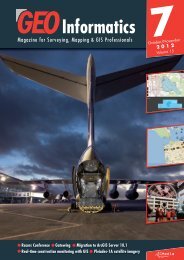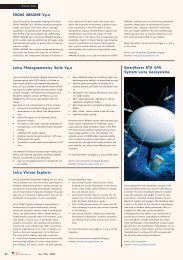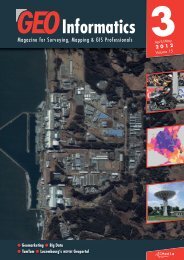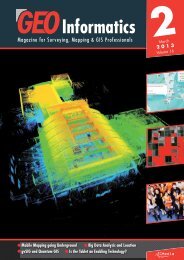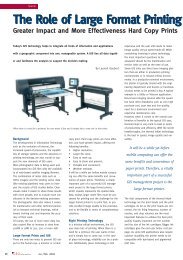2013 - Geoinformatics
2013 - Geoinformatics
2013 - Geoinformatics
You also want an ePaper? Increase the reach of your titles
YUMPU automatically turns print PDFs into web optimized ePapers that Google loves.
14<br />
A r t i c l e<br />
By Xavier Torret<br />
Requena, Josep Lluís Sala<br />
Sanguino and Carlos<br />
López Quintanilla<br />
This article presents a management model about open source technologies for<br />
the consideration of the government. The use of these types of technologies provides<br />
the user with technological authority, as well as transforming him or her<br />
into a provider with added value and a source of innovation and development.<br />
In addition, in Public Administration, when attempting to implement these types<br />
of tools, a new framework is created whereby new relationships with suppliers,<br />
based on information sharing, is established. The training of the municipal manager<br />
is a key element in implementing this change.<br />
Open Source Tools<br />
A R e a l i t y f o r L o c a l M a n a g e m e n t<br />
3. Freedom to study. The source code is available. How it has been<br />
created can be studied and an understanding of all of its structure<br />
can be obtained.<br />
4. Freedom to Modify. As there is access to the source code, it can be<br />
changed for improvements or customizations, and the new code will<br />
also be free and accessible.<br />
The only restriction imposed by free software is that it cannot be privatized.<br />
Free software will always be free.<br />
There are many examples of free software, from technology for Apache<br />
servers to operating systems such as Linux corporate databases such<br />
as MySQL, Postgre SQL, Desktop programs such as Openoffice, gvSIG,<br />
or Mozilla Firefox, as well as other types of content management technologies<br />
such as Moodle, Drupal or Joomla.<br />
Interface gvSIG Management System of Urban Pavement<br />
Introduction<br />
The objective of this paper is to present public officials with as much<br />
information as possible on open source technologies and the benefits<br />
obtained by opting for this type of technology. This document focuses<br />
on the management of urban services, where a great deal of responsibility<br />
is assigned to the manager, rather than the city, and where the<br />
efficiency and quality of service can be monitored by the public.<br />
Open Source Tools<br />
Open Source Tools are applications whose sources are freely released:<br />
– only software that is free can be freely released, and this is carried<br />
out through licenses that comply with the following four freedoms:<br />
1. Freedom of use. They can be used as many times, as often and for<br />
as long as desired.<br />
2. Freedom of distribution. They can be distributed to as many others<br />
as want to use them and as many copies as desired.<br />
Advantages of using open source tools<br />
These tools are a reality of the present, but more importantly the choice<br />
of the future; an option which will allow us to put effort into what really<br />
matters. In this sense, the software which will manage the information<br />
will not be as relevant as the data generated. Without a doubt, the<br />
data will be the most important.<br />
As these tools are open source and comply with interoperability standards,<br />
they provide us with the independence of the supplier, and thus<br />
we can have a broad professional structure at our disposal which<br />
always offers the best technical service possible.<br />
As they are free sources, they allow for scalable implementation, which<br />
will allow us non-convulsive migration living with proprietary models.<br />
Additionally, we can align the functionalities to the necessary services,<br />
which means that we will have software adapted to our needs.<br />
As there are no license costs, the savings we make will allow us to<br />
change spending into investment, enabling the training of employees<br />
or contracting businesses and local personnel. This approach will provide<br />
new opportunities. Free software provides opportunities.<br />
Finally, we should point out some further ideas to break away from the<br />
myths which have historically been associated with free software.<br />
June <strong>2013</strong>





